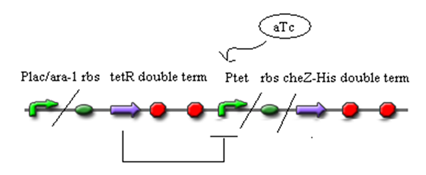Team:HKU-HKBU/speed control design
From 2009.igem.org
Speed Control - Design
E. coli propels itself from place to place by rotating the flagella. To move forward, the flagella rotate counterclockwise and form the motion called swimming. However, when the rotation changes to clockwise, the bacteria tumble in place and are unable to move.
In our bacteria-motor, we aim at the direct swimming of bacteria for propelling the motor and the adjustable speed of swimming within a certain range. The aim is achieved mainly by regulation of the expression level of CheZ gene. CheZ plays the key role here is due to its influence on the expression of CheY. A high level of phosphorylation of CheY protein in E. coli leads to the majority of bacteria tumbling movement, while a low level of phosphorylation of CheY protein in E. coli is found in non-tumbling bacteria and CheZ can function to reduce the level of phophorylated CheY in the bacteria. Therefore, when increasing the expression level of CheZ gene, we can reduce the tumbling movement, which in turn can increase the swimming speed of the bacteria to achieve the manipulation of speed.
This speed control system is constructed by knocking out the CheZ gene and transform an inducible plasmid with CheZ for the implement of adjustable control over the speed of the bacteria and hence the motor. There are two designs for this plasmid.
First Design
The first design is to use lacI as a repressor to prevent any leaky expression in the absence of the inducer. The promoter in this construct is Plac, which can be induced by IPTG.
In the proposed model, by changing the concentration of IPTG, we would be able to change the level of expression of CheZ and therefore the swimming speed of the bacteria.
Second Design
The second design is to use tetR as a repressor and Ptet as the regulator, which can be induced by aTc.
We suppose that by changing the concentration of aTc, the expression amount of protein CheZ will be changed, which results in the alternation of the swimming speed.
 "
"


